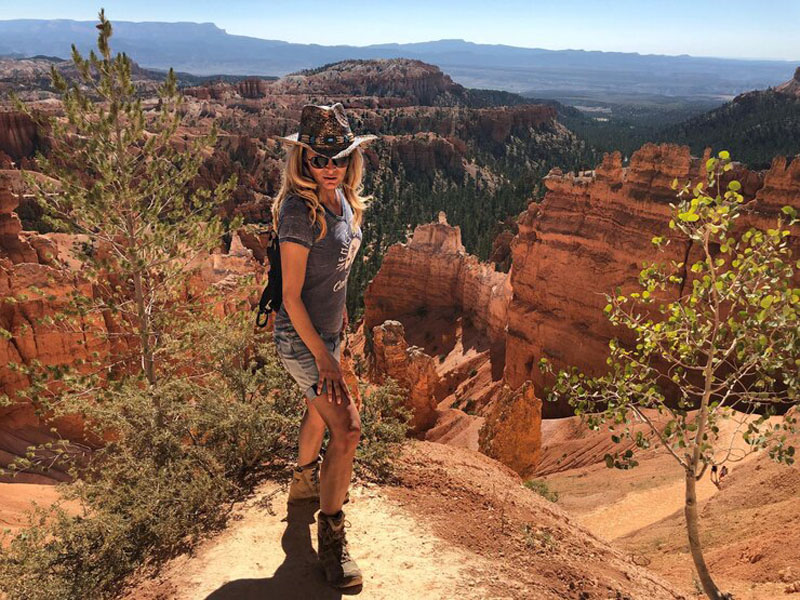Introduction
A Rim to Rim hike in the Grand Canyon is an iconic and tough journey. That draws hikers from all over the world. It involves crossing from one side of the canyon to the other encompassing a variety of landscapes. And providing an unforgettable experience.
Definition of a Rim-to-Rim hike
A “Rim to Rim” hike refers to the journey from the North Rim to the South Rim or vice versa. The hike can span anywhere from 21 to 24 miles depending on the route you choose. It’s a challenging task. That can be completed in a single, long day or over several days with camping. Hikers will arrange for a shuttle bus to return to their starting point after finishing the hike.
Overview of the Two Most Popular Routes
The two most famous Rim to Rim hike routes are the South Kaibab Trail to North Kaibab Trail and the North Kaibab Trail to Bright Angel Trail. Both routes are well maintained and offer unique challenges and scenery.
South to North Route – This route is about 21 miles long and has a total ascent of 6,400 ft. It usually takes between eight and twelve hours to complete. The trail starts and there is no water for the first 7 miles. Accommodations options on the North Rim are limited so there will be fewer crowds and a quieter experience.
North to South Route – Slightly longer, this course covers about 24 miles with a total ascent of 5,150 feet. Hikers can expect to spend nine to fourteen hours on this path. Unlike the South to North route, water is available at some point. There are numerous lodging and facility options at the end of the hike at the South Rim, which tends to be busy.
Both routes offer breathtaking perspectives and a feel of feat. That includes completing one of the maximum tough hikes inside Grand Canyon National Park. Whether you pick out the South to North or North to South path, the Rim to Rim hike is a memorable enjoy that requires careful planning and preparation.

Planning and preparation for the Grand Canyon Rim to Rim Hike
Importance of Planning Months in Advance the Grand Canyon Rim to Rim hike is a huge task. That calls for meticulously planning and preparation earlier. The reasons for this are numerous.
Permit Acquisition – depending on what you plan to do over the next 12 months and the direction you choose. You could need to secure permits for tenting or accommodations. These allows are in high demand and often promote out fast.
Accommodation – If you propose to stay overnight in the canyon, your options are limited and should be booked months ahead.
Physical Preparation -The hike’s difficulty necessitates a dedicated education routine to build endurance. And also energy.
Coordinating transportation to and from trailheads, especially. If you’re not finishing a round trip, includes coordinating trip services or personal arrangements.
Training and Mental Preparation Training for the Rim to Rim hike is not just about physical readiness; it’s also about mental strength. Here’s how to put it together.
Cardiovascular Fitness – Engage in normal cardio sporting events such as walking, cycling. As well as swimming to build stamina.
Strength Training – Focus on leg power through exercises. Like squats, lunges, and step-ups to prepare for hike elevation changes.
Hiking Practice – Embark on longer hikes. with elevation adjustments to acclimatize your body to similar conditions.
Mental Resilience – Prepare mentally by setting incremental goals. And then practicing mindfulness and visualizing the hike’s challenges and successes.
Necessary Gear and Supplies equipping yourself with the right equipment and materials is vital for a successful hike.
Footwear – Strong, comfortable hiking boots or trail footwear suited to the terrain.
Clothing – Lightweight, moisture-wicking clothing and layers for temperature adjustments.
In order to stay hydrated, you should have a reliable hydration system or water bottles with a capacity of at least 3 liters.
Food – High-energy, quickly digestible snacks and meals for sustenance at some stage of the hike.
Navigation Tools– Maps, a compass, or a GPS tool for path locating.
Emergency Kit – First aid supplies, a multi-device, and a whistle for emergency.
Sun Protection – Use sunglasses and a hat to protect against sun heat.
Lighting device – A headlamp or flashlight with a longer battery life for low light situations
By addressing these 3 essential components of making plans, training, and tools. You may be well on your way to a memorable and secure Rim to Rim hike experience. Remember, the key to conquering this project lies in thorough practice and a high-quality attitude.

Trail Details for the Grand Canyon Rim to Rim Hike
Description of Corridor Trails The Grand Canyon’s corridor path system is a network of maintained paths. That offer access to the canyon’s inner landscapes. The top trails on this machine are:
Bright Angel Trail – Starting from the South Rim, this path gives numerous rest houses with water and toilets. It descends 4,380 feet over 9 miles to the Colorado River.
South Kaibab Trail – Also beginning on the South Rim this trail offers panoramic views but does not have water resources along the way. It descends 4780 feet over 7.1 miles to the river.
North Kaibab Trail -This is the simplest maintained path from the North Rim descending 5761 feet over 14 miles to the river.
Availability of Water and Toilets – Water and bathroom facilities are positioned. Here’s what hikers can expect.
Bright Angel Trail – Water is available at the trailhead 1.5 Mile Rest house, Three Mile Rest house, Indian Garden, and Bright Angel Campground. Toilets are available at all these places besides Plateau Point.
South Kaibab Trail – There are no water stations but there are restrooms at Cedar Ridge and the Tip Off.
North Kaibab Trail – Water is available at Supai Tunnel. And then Roaring Springs Manzanita Rest Area and Cottonwood Campground. Toilets are available at these locations.
Lodging Options at the End of Each Route – At the end of the Rim to Rim hike lodging options depend on which rim you end up at.
South Rim – Offers many lodging options from inns like Maswik Lodge to camping sites like Mather Campground. The South Rim is more evolved and has more centers.
North Rim – Lodging is extra limited and includes the Grand Canyon Lodge and nearby options like Cliff Dwellers Lodge. The North Rim is much less crowded and more secluded.
These trails and centers are designed to provide hikers with a safe and fun experience in the Grand Canyon. It’s important to remember. That water availability can change seasonally so always check the current records before hiking.
Conclusion – The Grand Canyon Rim to Rim Hike Significance –
The Grand Canyon Rim to Rim hike is more than just a physical challenge. It an adventure that captures the spirit of journey and exploration. This hike is vast for numerous reasons.
A Test of Human Endurance and Perseverance –
The Rim to Rim hike is a testament to human patience. It pushes hikers to their limits both physically and mentally. Completing this hike is an enormous achievement. That demonstrates one ability to overcome barriers and endure challenging situations.
A connection with nature’s grandeur –
The hike gives an intimate experience of one of the world most awe-inspiring natural wonders. It allows hikers to witness the Grand Canyon grandeur from within offering an unusual perspective that few get to look at. This connection with nature can be a profound and life-changing experience.
An educational experience –
The canyon adventure is also educational. Hikers learn about the Earth geological records as the layers of the canyon walls tell a story that spans millions of years. It’s a chance to gain a deeper understanding of our planets beyond.
A moment of solitude and reflection –
The Rim to Rim hike offers moments of solitude allowing hikers to reflect on their lives and the splendor of the natural world. Less than 2 % of Grand Canyon site visitors spend a night on the canyon floor presenting a sense of exclusivity and peace.
A cultural and historical exploration
The Grand Canyon is not only a natural wonder but it is also a cultural and historic landmark. Indigenous peoples have inhabited the area for thousands of years. And also the hike presents a perception of their history and courting of the land.
Environmental awareness and conservation –
Hikers who undertake the Rim to Rim hike develop a greater appreciation for environmental protection. The experience can encourage a commitment to protecting natural spaces. And also ensuring they stay untouched for future generations to enjoy
In conclusion – the Rim to Rim hike is big for its capacity to challenge, educate inspire, and rework those who undertake it. It’s an adventure that goes beyond more physical achievement. Offering profound engagement with the natural world and oneself. The memories and training from this hike can last a lifetime making it a surely unforgettable experience.



